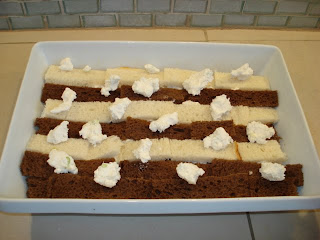I can't recommend Paule's class highly enough. She's spirited, enthusiastic, a natural teacher and intuitive cook. She keeps up with the current Parisian trends, and introduced us to the then newly in vogue tonka bean (more about that another time). After marketing and preparing a wonderful lunch in her loft-style apartment, she leads a walking tour around Paris, stoping in at the most marvelous establishments, including the famed Dehillerin cookware shop, where she's well-known and obviously well-loved. And I'll never forget being invited down into the cozy, warm basement below the Poilane bakery, where this Mr. Clean-type guy in white short shorts, slip-on keds and one of those Frenchy blue striped bateaux-collared shirts baked those iconic round, hard crusted loaves. He never stopped smiling and the ancient room and equipment were astonishingly immaculate. Fun times.
Paule came to New York this December to host a Christmas in Paris cooking class. Madeleines aux Truffes (presented here). Chicken stuffed with truffles and foie gras. Gratin of winter vegetables with more black truffles. Freshly sliced black truffles dipped in olive oil for light snacking. And Paule's magnificent Caramel au Chocolat tarte which I'm going to post soon.
I made these in St. Louis this Christmas and they were very well received.
Madeleines aux Truffes
Madeleines with Black Truffles
6 T. powdered sugar
1 3/4 c. flour
1 t. baking soda
3 eggs
1/2 c. whole milk
1/4 t. salt
1 (4 oz.) stick of butter
3 T. black truffle oil
2 buck-eye sized black truffles, fresh is best but jarred will work well too
Any truffle juice accumulated in the jar
Beat eggs well until very frothy, and then beat in the milk.
Mix together the powdered sugar, flour, baking soda and salt and gradually add to egg mixture while beating. You want the batter to be very smooth.
Melt the butter on low power in the microwave -- ideally you want it barely melted, just really really soft with only part of it liquid. Not hot.
Slowly beat in the butter and the truffle oil (and juice if you have it).
Shave the truffles whisper thin on a truffle slicer (even the formidable OXO mandoline can't slice as thinly as true truffle slicer). Julienne the slices into thin thin strips. Collect up every little precious scrap and stir these into the batter.
Refrigerate the batter until it's very stiff. Three hours recommended -- though you can do an express chill in the freezer, just make sure to stir every five minutes or so, so it chills evenly. Paule says the chilled batter will expand better due to "thermic shock." I also have a theory that this additional time the truffles spend in the batter before baking allows the flavor to further permeate the batter. Another benefit is that the stiff batter is much easier to work with, at room temp it's pretty sticky stuff.
Preheat oven to 400 degrees.
Butter your madeleine trays -- regular size or minis. Fill each mold about 3/4 full. Bake the mini molds 10-12 minutes -- til they're puffed and golden brown around the edges. The larger size molds should take 12-15 minutes tops. Not too brown!
They should slide right out of the pan onto a rack. Best while still hot from the oven, though you can also prepare ahead and gently reheat before serving. They are pretty resiliant.































